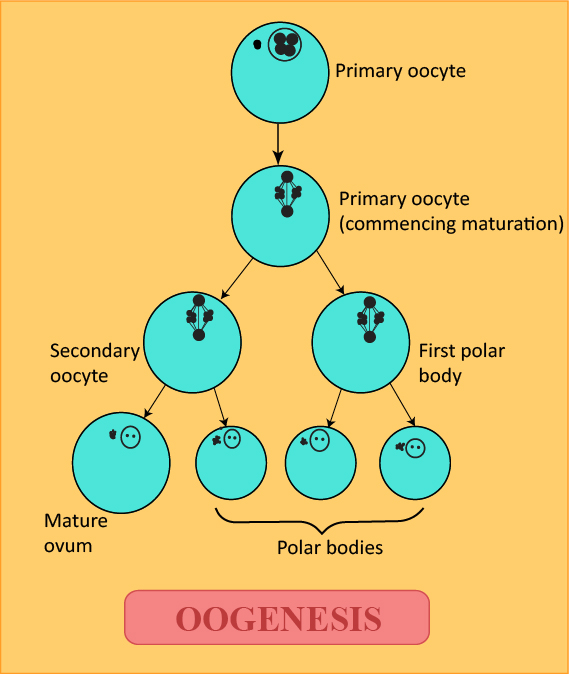
The process of formation of ova is called which of the following:
(a) Ovulation
(b) Oviparous
(c) Oogenesis
(d) None of the above
Answer
550.8k+ views
Hint: The cell which is released from the female reproductive organs and is capable of developing a new organism when fertilized or united with a sperm cell is known as ova.
Complete answer:
The process of formation of ova is known as oogenesis in which the female gamete is produced and is transported through the fallopian tube where it gets fertilized by the sperm cells. Oogenesis is initiated in the embryonic stage and is the first part in mammals which starts in the germinal epithelium and gives rise to the development of ovarian follicles which are the functional unit of the ovary. It constitutes several sub-processes such as cytogenesis, osteogenesis, and the maturation to form an ovum. The common process of gametogenesis is the creation of ammonia with the processes of folliculogenesis which is a separate subprocess that supports all three genetic sub-processes. It enters miosis during embryonic development and becomes a site where the DNA replication with meiosis begins and the mortar crossing over takes place which stops in early prophase.
Additional Information:
Ovulation: It is a part of the menstrual cycle that occurs when an egg is released from the ovary and may not be fertilized by the sperm. The egg travels to the uterus and implants itself to develop into a pregnancy if the egg is fertilized. If it is left unfertilized then the egg disintegrates and the uterine lining shed during your periods. It happens around 14 of a 28-day menstrual cycle and occurs in the four days before or four days after the cycle's midpoint.
Oviparous: They are the animals that lay their eggs and constitute no other embryonic development within the mother. It is the reproductive method of several reptiles, snakes, birds, amphibians, and fishes. The unfertilized oocytes include any mechanism where the young are born live for the development of The young is supported by either parent or any part of the body.
So, the correct answer is 'Oogenesis'.

Note: The biggest cell of the body is the egg cell which is around a hundred microns in diameter similar to the strand of a hair. After the process of ovulation and egg doesn't live very long, which is about two weeks and the females are born with all the eggs we will ever have.
Complete answer:
The process of formation of ova is known as oogenesis in which the female gamete is produced and is transported through the fallopian tube where it gets fertilized by the sperm cells. Oogenesis is initiated in the embryonic stage and is the first part in mammals which starts in the germinal epithelium and gives rise to the development of ovarian follicles which are the functional unit of the ovary. It constitutes several sub-processes such as cytogenesis, osteogenesis, and the maturation to form an ovum. The common process of gametogenesis is the creation of ammonia with the processes of folliculogenesis which is a separate subprocess that supports all three genetic sub-processes. It enters miosis during embryonic development and becomes a site where the DNA replication with meiosis begins and the mortar crossing over takes place which stops in early prophase.
Additional Information:
Ovulation: It is a part of the menstrual cycle that occurs when an egg is released from the ovary and may not be fertilized by the sperm. The egg travels to the uterus and implants itself to develop into a pregnancy if the egg is fertilized. If it is left unfertilized then the egg disintegrates and the uterine lining shed during your periods. It happens around 14 of a 28-day menstrual cycle and occurs in the four days before or four days after the cycle's midpoint.
Oviparous: They are the animals that lay their eggs and constitute no other embryonic development within the mother. It is the reproductive method of several reptiles, snakes, birds, amphibians, and fishes. The unfertilized oocytes include any mechanism where the young are born live for the development of The young is supported by either parent or any part of the body.
So, the correct answer is 'Oogenesis'.

Note: The biggest cell of the body is the egg cell which is around a hundred microns in diameter similar to the strand of a hair. After the process of ovulation and egg doesn't live very long, which is about two weeks and the females are born with all the eggs we will ever have.
Recently Updated Pages
Master Class 12 Business Studies: Engaging Questions & Answers for Success

Master Class 12 Economics: Engaging Questions & Answers for Success

Master Class 12 English: Engaging Questions & Answers for Success

Master Class 12 Maths: Engaging Questions & Answers for Success

Master Class 12 Social Science: Engaging Questions & Answers for Success

Master Class 12 Chemistry: Engaging Questions & Answers for Success

Trending doubts
What are the major means of transport Explain each class 12 social science CBSE

Which are the Top 10 Largest Countries of the World?

Draw a labelled sketch of the human eye class 12 physics CBSE

How much time does it take to bleed after eating p class 12 biology CBSE

Explain sex determination in humans with line diag class 12 biology CBSE

Differentiate between homogeneous and heterogeneous class 12 chemistry CBSE




